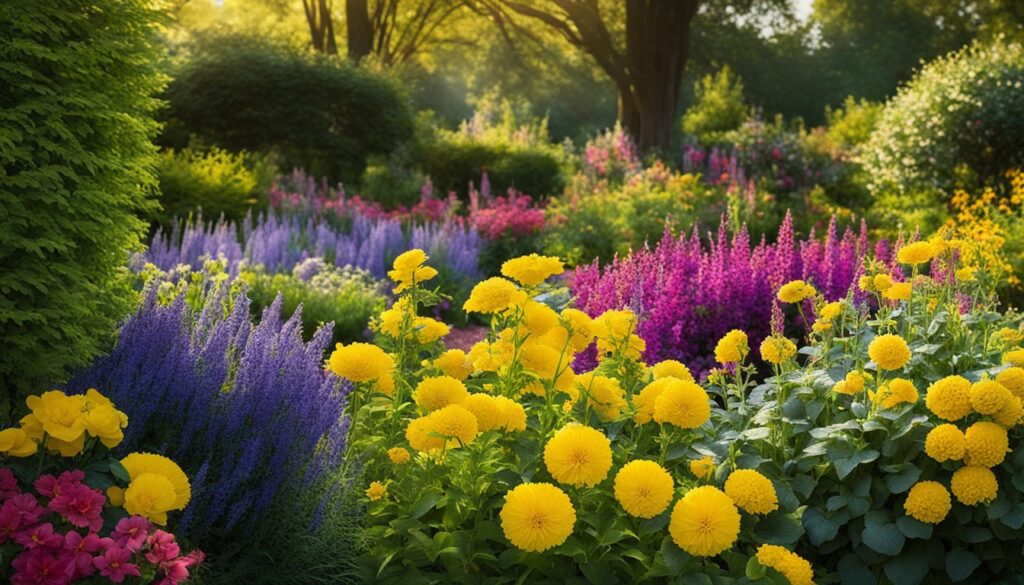Every time I add a new yellow perennial to my garden, it feels like I’m spreading sunshine. These flowers bring lasting brightness and a natural glow to our gardens. In the United States, gardeners love the joy these yellow flowers bring to their perennial gardens. They remind us of nature’s endless optimism.
The American Gold Rush, a favorite among gardeners, won the All American Selection Award in 2020 for its bright spirit1. Like life’s many moments, garden flowers in yellow can be tall and bold or low and unassuming. For example, the Lemon Meringue baptisia hybrid grows up to 36 inches, while the Sedum Yellow Brick Road stays at just 8 inches1.
In my garden, I’ve planted the Firefly Sunshine yarrow, reaching up to 30 inches, alongside the 24-inch tall Droplets of Tuscan Gold false sunflower. Together, they show the wide range of yellow flowers that can brighten perennial gardens in zones 3 to 912.
Key Takeaways
- Understanding the All-American appeal of yellow perennials like the American Gold Rush1.
- Height variety in yellow perennials from the towering Lemon Meringue baptisia to the ground-hugging Sedum Yellow Brick Road demonstrates their versatility1.
- Yellow flowers bloom across different zones, ensuring most gardeners can enjoy their luminosity2.
- Cultivating a garden with varying heights can create a visual symphony in yellow hues1.
- Strategic selection based on bloom times can result in a season-long display of yellow beauty2.
The Cheerful Impact of Yellow in Your Garden
Yellow flowers bring joy to our gardens. They are the brightest color in the spectrum, lighting up even the gloomiest days. Daffodils and primroses, with their bright yellow, welcome spring and celebrate Easter’s vibrancy3.
Yellow adds beauty to gardens, from warm tones to bright canary hues. It matches well with greens for a peaceful look or contrasts with purple and blues for drama, like in Van Gogh’s art3.
Yellow flowers are not just pretty; they’re also visible in the evening. Real estate agents suggest planting them at your home’s front to improve curb appeal4. This color brightens dark spots, making your garden welcoming.
Yellow is key in sustainable gardening, helping with biodiversity and water use4. Using yellow alone or with white and blue creates a lively, eco-friendly garden3.
Yellow brings warmth and joy to gardens, making it a must-have for gardeners. By using different shades of yellow, you create a garden that shines all year round.
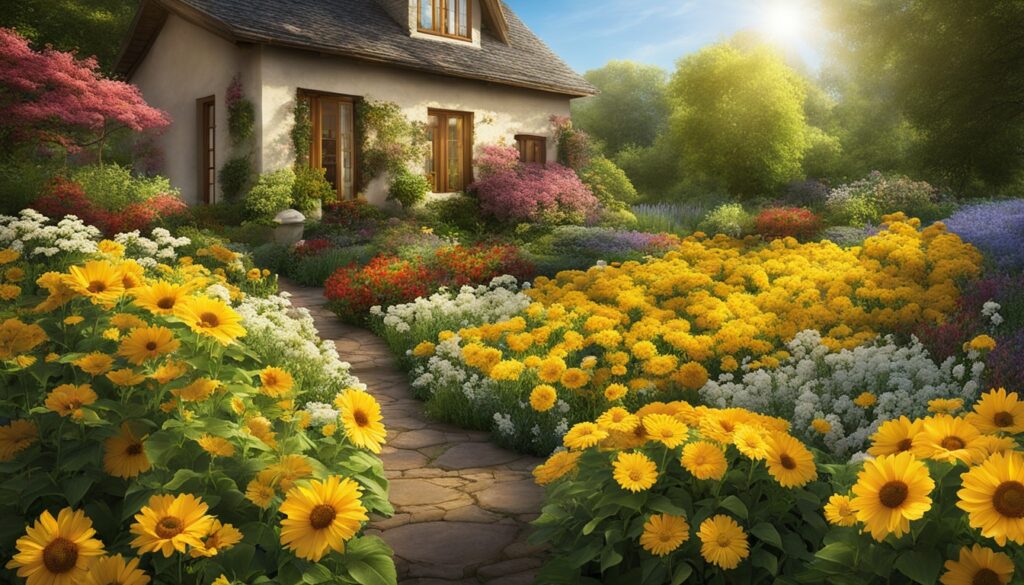
Creating Harmony with Yellow Perennials and Color Theory
Adding yellow perennials to your garden is more than just adding color. It’s a careful balance with Color Theory to make sure each color works well together. Using color theory makes your garden look better and boosts the Garden Aesthetics. It turns your garden into a work of art.
Yellow is a key color that can change your garden’s look. When you pair it with purple, its opposite on the color wheel, you get a strong contrast. This contrast makes the garden more lively5. Colors opposite each other on the wheel make each other stand out6.
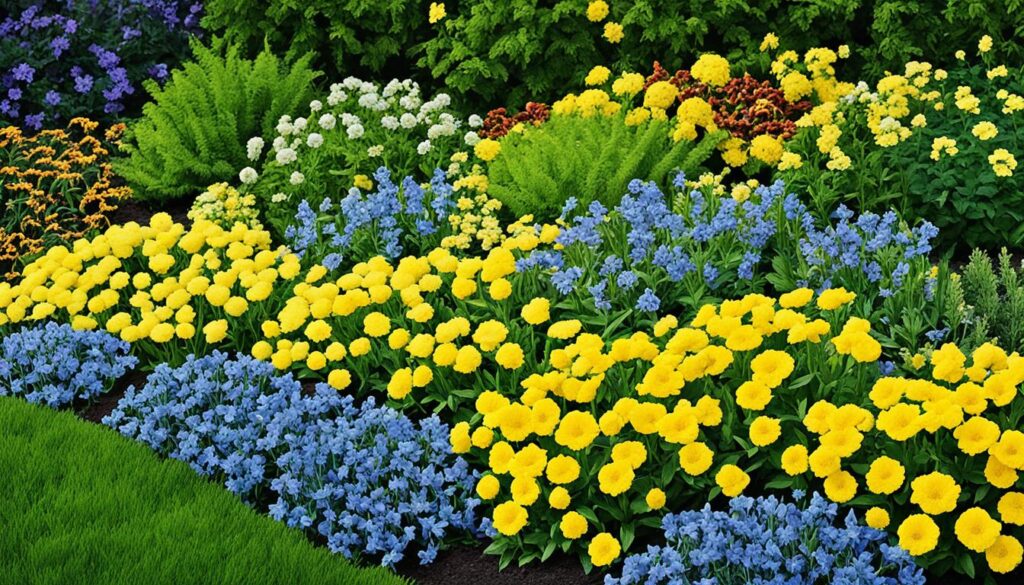
For a gentler garden look, try colors next to each other on the wheel. Use yellow, orange, and amber for a smooth transition of colors. This creates a warm and welcoming feel6.
Using triadic color schemes is another bright way to garden. This means picking colors like yellow, blue, and red that are spread out on the wheel. It gives your garden a colorful and balanced look6.
If you’re feeling bold, try a tetradic scheme. This uses two pairs of colors like yellow and violet, and green and red. It adds a lively touch to your garden6. The secret to a great garden is choosing colors that work well together in different lights and seasons.
Flowering Plants add more than beauty to your garden. Their colors can change how you feel. Yellow flowers make a garden feel happy and inviting.
In short, whether you want a calm or lively garden, using color theory with yellow perennials is key. It makes your garden not just pretty but also a place of joy.
Garden Flowers: A Spectrum of Yellow Shades
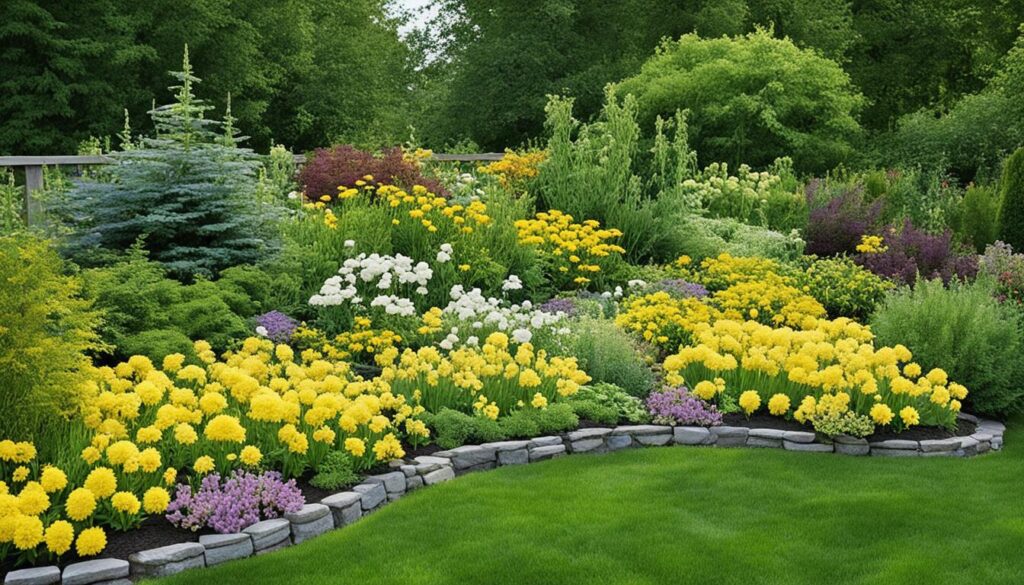
Adding yellow perennials to your garden can make it bright and welcoming. Colors in the garden show off your style and set the mood. Yellow flowers, especially, are key for creating these effects. They range from soft spring shades to bright summer tones, offering endless options for gardeners.
I love how Seasonal Florals change with the seasons, each bringing its own beauty. For example, cool yellow flowers like crocus and daffodils welcome spring. Later, warm yellow perennials like goldenrod and sunflowers fill the garden with summer color7.
To make these colors pop, I use color theory in my planting. Gardener Gertrude Jekyll suggested pairing yellow with gray or lime-green foliage and white flowers7. This not only makes my garden look better but also helps plants grow well together.
| Flower Variety | Height Range | Spread Range |
|---|---|---|
| Supertunia® Saffron Finch™ petunia | 6 to 10 inches | up to 2 feet |
| Superbells® Lemon Slice® calibrachoa | 6 to 12 inches | up to 2 feet |
| Suncredible® Yellow sunflower | 24 to 36 inches | 20 to 32 inches |
| Double Delight® Primrose begonia | 8 to 14 inches | up to 2 feet |
| Lady Godiva® Yellow pot marigold | 10 to 16 inches | 12 to 18 inches |
When planning my garden, I consider each plant’s height and spread. This ensures each plant shines without overshadowing others8. This careful planning has made my garden a personal sanctuary with yellow perennials.
Yellow in garden design draws the eye and brings warmth and energy. For me, well-designed garden beds with yellow flowers do more than look good. They create a space for joy and celebration. Whether you’re new to gardening or have experience, yellow perennials will make your garden special.
Cultivating Visual Interest with Varieties of Heights and Blooms
As a gardener, I love making spaces look lively with different heights and types of yellow perennials. By picking perennials of various heights, from low Rudbeckia to tall Baptisia, we can create layers that catch the eye and highlight our flower beds9.
In my garden, I start with shorter blooms up front and go taller towards the back. This way, each plant gets enough sunlight and looks great from where you stand10. This setup adds depth and makes the garden look balanced. Plus, putting plants with similar needs together helps them grow well and makes caring for the garden easier9.
Keeping these gardens looking good means regular care like mulching, watering, and checking how plants grow and spread. It’s important to think about how the garden will look now and in the future9.
| Plant Name | Height Range | Seasonal Interest |
|---|---|---|
| Baptisia | 3-4 feet | Spring to Early Summer |
| Rudbeckia | 1-2 feet | Late Summer to Fall |
| Daylily | 1-2 feet | Early to Mid-Summer |
Creating a perennial garden is about more than just looks. It’s about knowing how plants will work and grow together over time. My gardening style supports local wildlife and keeps the garden lively all year with a mix of plants.
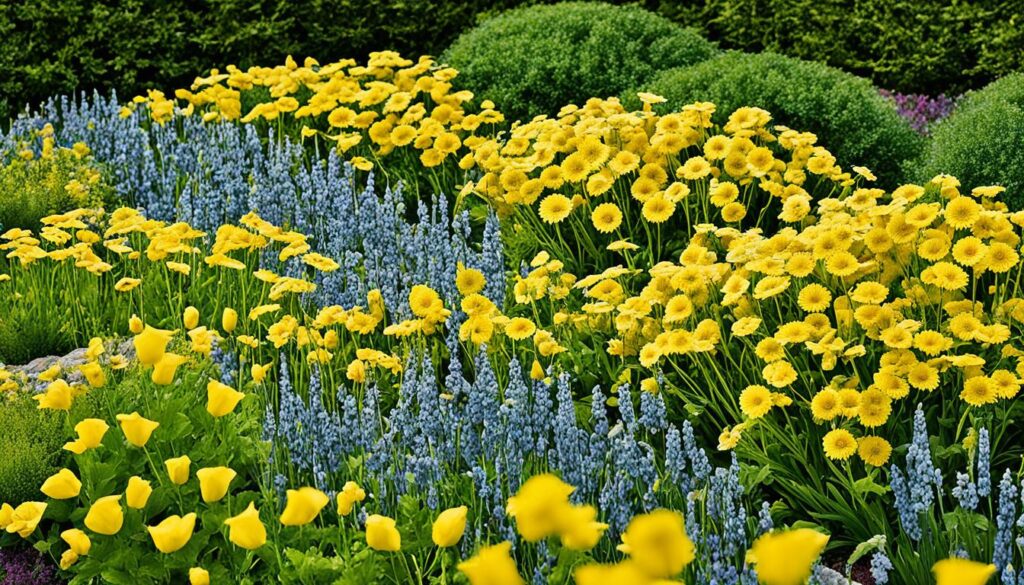
Yellow Perennials and Their Pollinator Partners
Yellow perennials make any garden look stunning and help local wildlife and bees. In a Pollinator-Friendly Garden, it’s key to pick plants that bloom for a long time. This attracts different pollinators all year round. Early bloomers like Forsythia and Winter Aconite give bees nectar in spring11.
Having plants that bloom at different times keeps my garden lively from spring to fall. Summer plants like Coreopsis and Coneflowers draw more butterflies and bees, which is good for pollinators11. Plants like Black-Eyed Susans and Chrysanthemums bloom in fall, giving bees food before winter11.
When making a Wildlife Gardening space, mix plants that bloom at various times and meet wildlife’s needs. The yellow perennials I picked are beautiful and help pollinators by offering pollen and nectar. This supports bees, which are in decline12.
My garden is a small but important part of the ecosystem thanks to my careful choices. Seeing the variety of pollinators it attracts is rewarding. Each plant was chosen to help pollinators all season long. Here are some yellow perennials that make my garden a pollinator paradise.
| Plant | Season | Benefits |
|---|---|---|
| Spurge | Spring | Early bloom, attracts first-activity bees11 |
| Coreopsis | Summer | Drought tolerant, bee and butterfly magnet11 |
| Black-Eyed Susans | Fall | Long blooming, supports bees and butterflies into late season11 |
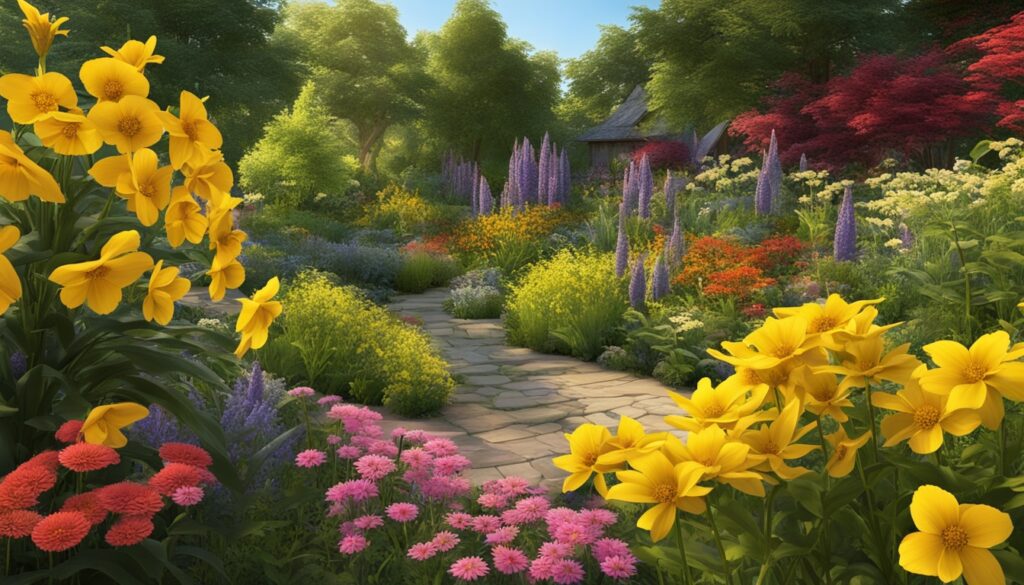
By planting carefully and focusing on pollinators, I’ve seen how a Pollinator-Friendly Garden helps. It’s not just about bees; it’s a place where wildlife can live well. My garden is a safe spot for bees, butterflies, and hummingbirds, filled with what they need to thrive12.
Embracing Low-Maintenance Yellow Perennials for Busy Gardeners
For those with busy lives, creating a easy-care garden with vibrant yellow perennials is possible. The Zagreb Coreopsis is a top choice for low-effort gardening. It blooms from mid-summer to early fall, needing little care to stay bright13. It loves full sun and can grow well in tough soil, but it does need regular watering when it’s dry13.
Choosing the right perennials is key for busy gardeners. The Black-Eyed Susan is great for attracting pollinators and doesn’t need much water. It’s perfect for sustainable gardens that stay colorful14.
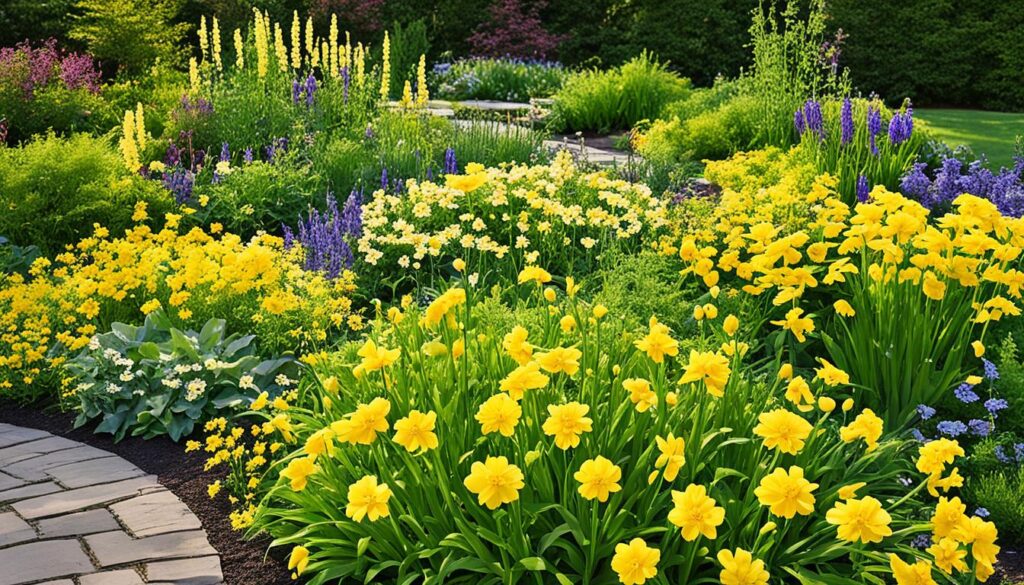
Adding perennials like Yarrow or Society Garlic also helps reduce garden work. Yarrow is tough and provides beautiful leaves and flowers all season. It fits well into a perennial maintenance plan that values time and looks14.
The Coreopsis verticillata ‘Zagreb’ is a great choice for zones 3-9. It grows to 18 inches tall and attracts bees, butterflies, and hummingbirds. It’s easy to care for, needing only some deadheading to keep blooming13. This shows the beauty of easy-care garden flowers.
Yellow perennials are not just pretty; they’re also easy to care for. They become the backbone of a garden, coming back every year with little work from us. By choosing these plants, we create a beautiful garden that lets us enjoy life more.
Incorporating Yellow Perennials into Containers and Flower Beds
Container gardening is a great way to use small spaces creatively. Adding yellow perennials like the Kelvin Floodlight Dahlia and Stella D’Oro Daylily turns a simple container into a bright spot. These flowers are perfect for those who love making flower arrangements and want to brighten up city gardens15.
Putting these yellow flowers in beds or pots is both beautiful and practical. Yellow lilies work well along borders and make any space feel welcoming with their bright colors16. Using them in vertical gardens or feng shui flower beds can make the most of space and add peace and happiness16.
| Perennial Type | Ideal Setting | Key Features |
|---|---|---|
| Kelvin Floodlight Dahlia | Containers, Large Flower Beds | Large blooms perfect for focal points in floral arrangements15 |
| Stella D’Oro Daylily | Small to Medium Pots, Mixed Borders | Adapts well across zones 2-9, low-maintenance15 |
| Yellow Lilies | Vertical Gardens, Border Edges | Enhances garden layers, thrives in full sun, reliable color through seasons16 |
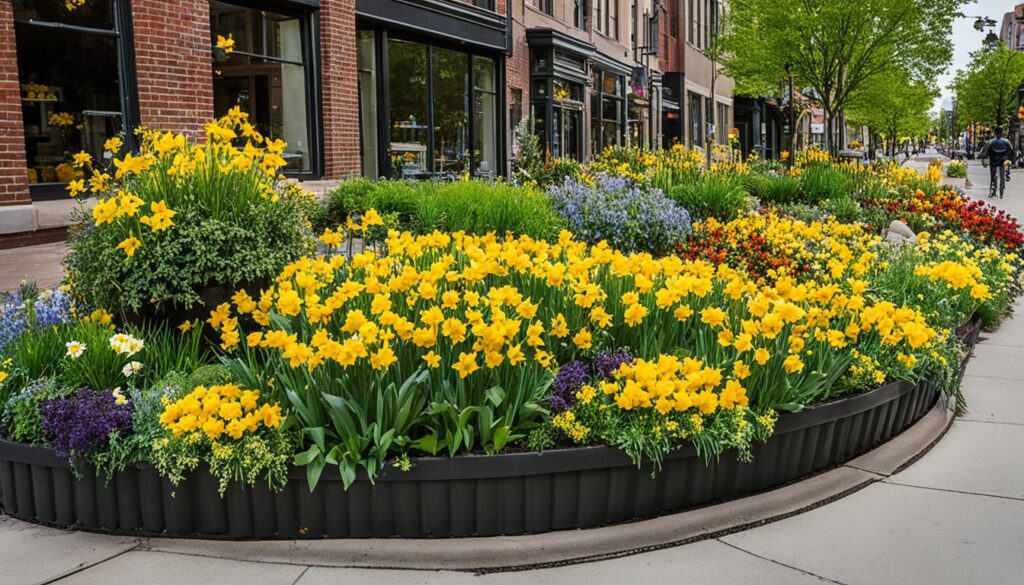
Planting at the right time makes a big difference. For example, planting yellow lilies so they bloom at different times keeps my garden lively from spring to fall16. This planning is key to keeping containers interesting all season.
Yellow perennials are great because they look good and fit in many places. They meet both beauty and practical needs, especially in gardens that are easy to care for15. Adding these plants to containers and flower beds lets me create a magical, lively city garden.
Maximizing Garden Display with Seasonal Yellow Floral Selections
When planning your garden, think about how each season can add beauty and function. By using seasonal flowers, you can keep your garden looking great all year. Let’s see how to make the most of each season’s flowers.
Spring Bloomers
Spring brings color with early bloomers like crocuses and daffodils. These flowers help other plants grow by attracting bees and butterflies. This makes your garden healthier and more vibrant17.
Summer Showstoppers
Summer is when flowers like Coreopsis and Hemerocallis shine. Using flowers like marigolds and lavender helps plants grow and keeps pests away17. Perennials like coneflowers and shasta daisies bloom all summer, adding long-lasting yellow beauty18.
Fall Favorites
Fall brings colors like Solidago and Rudbeckia to your garden. Grouping plants in threes keeps your garden looking good with autumn’s yellows and reds19.
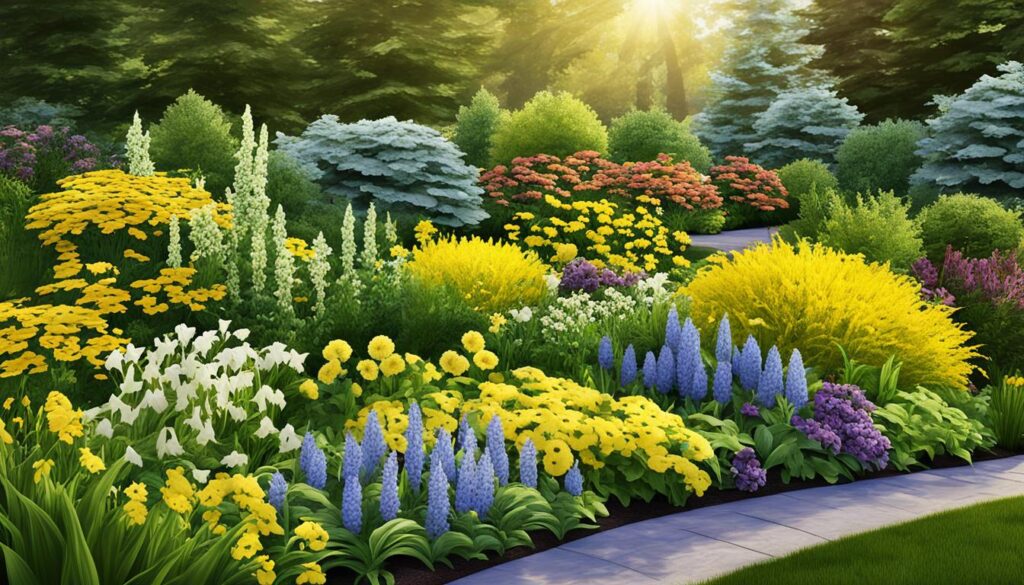
Using seasonal flowers helps your garden look great and stay sustainable. The key is to put the right plant in the right spot at the right time. This way, your garden will be beautiful all year.
Unique Yellow Perennials for Stand-Out Garden Features
I love finding new plants for my garden that add color and texture. Yellow perennials like Kniphofia ‘Solar Flare’ and Old Yella tender hibiscus really stand out. They bring a unique touch to the garden.
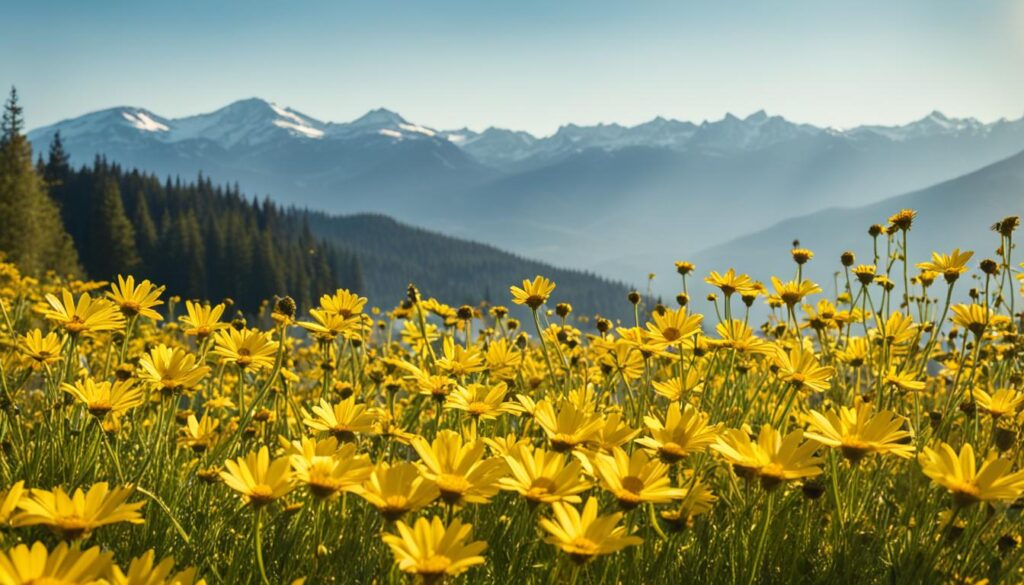
In cooler areas, Zone 5a is where plants like Fireworks Goldenrod shine. They bloom late into the season, adding color and attracting pollinators20. Their unique flowers are a highlight of the garden, helping it stay healthy20.
The Rudbeckia Brown Eyed Susan has become a staple in my garden. It’s easy to care for and spreads on its own, adding vibrant color20.
| Plant | Height | Bloom Season | Special Features |
|---|---|---|---|
| Kniphofia ‘Solar Flare’ | Up to 36 inches | Early to mid-summer | Vibrant fire-orange blooms |
| Old Yella Hibiscus | Up to 48 inches | Mid-summer to early fall | Large, pale yellow flowers |
| Fireworks Goldenrod | Up to 36 inches | Late summer to fall | Cascading yellow blooms that attract pollinators |
| Rudbeckia ‘Brown Eyed Susan’ | Up to 24 inches | Mid to late summer | Durable and self-seeding with eye-catching blooms |
The Yellow Wild Indigo and Moonshine Yarrow are fascinating for their unique looks and strong blooms. They add to the garden’s beauty and diversity20. If you want to brighten up your garden, these yellow perennials are a great pick. They promise a lively look all season long.
The Role of Yellow Perennials in Landscape Horticulture
Yellow perennials are key in ornamental gardening, adding beauty and helping ecosystems. They come in various sizes and colors, from the tall Toucan® Yellow Canna Lily to the low-growing GoldDust® Mecardonia21. This variety lets gardeners create layered, interesting gardens.
These plants love different amounts of sunlight, making them perfect for any garden spot21. The Superbells® Lemon Slice® Calibrachoa loves full sun, while the Purslane ‘Mojave® Yellow’ Portulaca does well in sun to part-sun21. This means gardens can stay beautiful all day long.
Yellow perennials are tough and grow well in zones 9-11, making them great for all gardeners21. They’re also deer-resistant, keeping gardens safe from wildlife21. For dry areas, there are drought-resistant types that save water and look beautiful21.
Planting yellow perennials in early fall or spring can make your garden look amazing by spring22. This planning helps flowers bloom at different times, making the garden look great all season22.
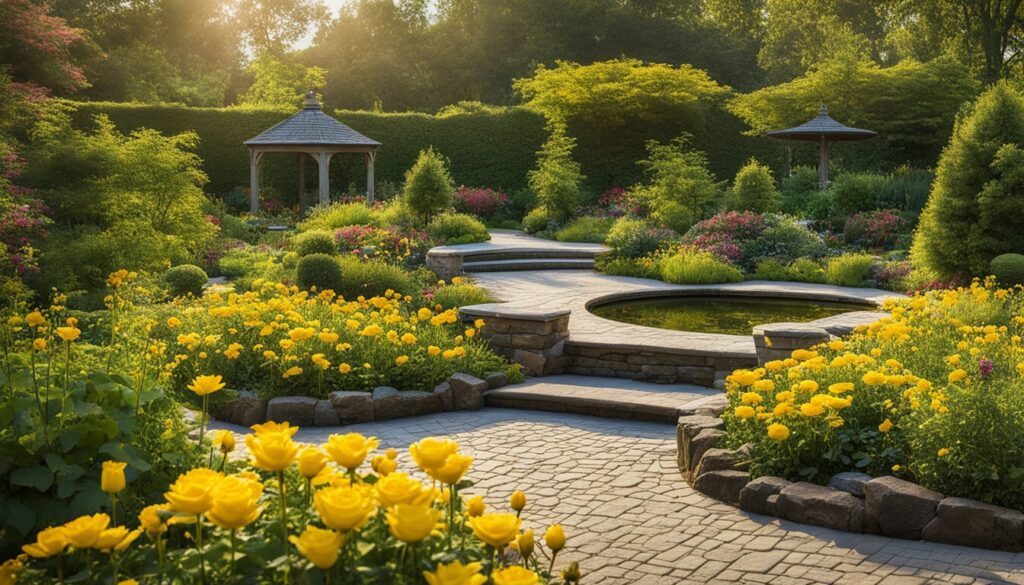
Yellow perennials do more than just look good. They help bees and other pollinators by providing food21. You can pick plants for any sunlight level, like the Chelidonium majus for shade or Lotus corniculatus for full sun23. This variety supports wildlife and keeps your garden healthy and pretty.
| Plant Type | Sunlight Requirement | Height Range |
|---|---|---|
| GoldDust® Mecardonia | Full Sun | 2-5 inches |
| Toucan® Yellow Canna Lily | Full to Part Sun | 30-48 inches |
| Superbells® Lemon Slice® Calibrachoa | Full Sun | 6-12 inches |
| Purslane ‘Mojave® Yellow’ Portulaca | Full to Part Sun | 4-8 inches |
Choosing the right plants for your garden boosts biodiversity and makes a sustainable ecosystem21. Yellow perennials are a great choice for these goals.
Combating Garden Pests and Diseases in Yellow Perennials
Keeping yellow perennials like Hibiscus and Sedum bright and healthy means watching out for pests and diseases. A good plan for Garden Health and Pest Management is key. Knowing which plants are prone to certain diseases, like Rudbeckia ‘American Gold Rush’ and Septoria Leaf Spot, helps stop problems before they start.
Aphids, which can be many colors, love to attack new growth, making leaves and flowers look bad24. To fight them, using garlic soup can help because it keeps away fungal, viral, or bacterial diseases25. Japanese beetles, with their shiny colors, eat leaves and flowers, causing big damage if not stopped quickly24. Putting in larkspur or delphinium leaves can keep these beetles away25.
For Plant Disease Prevention, organic methods work well. Chamomile tea is good because it fights bacteria and fungus, keeping plants healthy and safe from diseases25. Also, planting flowers like sweet alyssum and candy-tufts can bring in helpful insects that eat pests26.
Here’s a quick look at how to keep pests away from yellow perennials:
| Pest/Disease | Natural Remedy | Plants Benefitted |
|---|---|---|
| Aphids, Mealybugs | Garlic soup, Soap Spray | Hibiscus, Sedum |
| Japanese Beetles | Larkspur or Delphinium Blend | Rudbeckia, Daisies |
| Fungus & Mildew | Chamomile Tea | All Yellow Perennials |
| General Pests | Beneficial Insects (Sweet Alyssum, Candy-tufts) | Most Garden Varieties |
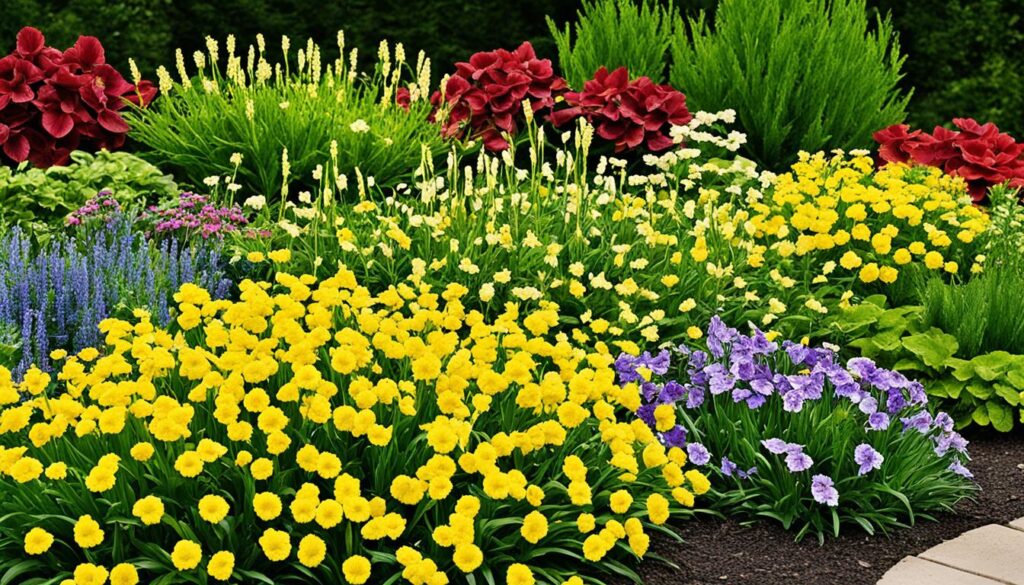
Even with challenges, yellow perennials like goldenrod and daylilies can make your garden look great. Using these Pest Management tips helps keep your garden healthy and beautiful. It makes sure your garden is a place where beauty and taking care of the planet go hand in hand.
Pairing Yellow Perennials with Complementary Garden Aesthetics
Exploring garden design, the art of Aesthetic Pairings is key. It makes your garden look better and keeps it healthy. By choosing the right plants together, you make your garden more beautiful and balanced.
Studies show that 70% of the best plants for yellow lilac are perennials27. Colors like yellow, blue, purple, and white make your garden pop27. This mix of colors keeps your garden bright from spring to summer with different plants27.

Knowing how plants work together helps you pick the best pairings. For example, lavender is great with yellow flowers because it keeps pests away and attracts bees27. But, don’t put yellow lilac near roses or sunflowers because they might fight over food and attract pests27.
| Plant Pairing | Benefits | Season |
|---|---|---|
| Lavender and Yellow Lilac | Pest Repellent, Attracts Pollinators | Spring to Summer |
| Yarrow and Daylily | Textural Contrast, Attracts Beneficial Insects | Spring to Late Summer |
| Catmint and Yellow Lilac | Early Color Burst, Attracts Pollinators | Early Spring |
| Astilbe and Coneflower | Extends Blooming Season, Colorful Display | Summer to Late Summer |
Your garden should be both beautiful and sustainable. Make sure plants need the same amount of water and sunlight28. This way, your garden will be lovely and healthy, showing off the beauty of well-chosen plant friends.
Conclusion
Thinking about the amazing variety and strength of yellow perennial garden flowers, I realize their big impact on our gardens and lives. They bring more than just beauty; they help us garden sustainably29. By choosing different shapes, sizes, and colors, my garden shows my style and supports my well-being29.
Taking care of perennials is about keeping our gardens beautiful and protecting the planet. Yellow perennials help our pollinators and add to the variety of life29. They also clean the air by taking in carbon dioxide and releasing oxygen, making our neighborhoods healthier29. This shows that caring for my garden helps the environment too29.
Looking at landscape design, I’ve learned how important it is to pick the right plants for pollinators and the environment30. The way flowers face and the types of pollinators they attract is key for a healthy garden30. Thinking about the long history of yellow perennials, over 130 million years, makes me respect their journey31. These plants have seen and shaped our world, becoming the diverse and vibrant life we love today31.
FAQ
What are some popular yellow perennial garden flowers for adding to my landscape?
How can yellow flowers affect the feel of my garden?
Can you explain how to use color theory when planting yellow perennials?
What are the differences between cool and warm shades of yellow in perennial flowers?
How should I consider bloom shapes and heights when planning my garden with yellow perennials?
Why are yellow perennials good for attracting pollinators?
What are some low-maintenance yellow perennial options for my busy lifestyle?
Can yellow perennials be grown in containers?
Which yellow perennials are best for each season?
How can unique yellow perennials serve as standout features in my garden?
How do yellow perennials contribute to landscape horticulture?
Are there pest or disease concerns with yellow perennials?
How can I pair yellow perennials effectively with other plants in my garden?
Source Links
- 20 Yellow Perennial Flowers With Names and Pictures
- 16 Yellow Perennials | Walters Gardens, Inc.
- How to use Yellow in the garden
- Grab Attention With Yellow in the Garden – Fine Gardening
- How to Create a Colorful Garden – Garden Design
- Design 101 – Using Color Theory
- How to Use Yellow in Your Flower Garden
- 34 Yellow Flowers for Your Garden – Garden Design
- Landscape Design Using Perennials
- How to Design a Harmonious Flowerbed – Atlantic Landscapes
- Yellow Perennial Flowers: Vibrant Blooms For Your Garden
- 10 Perennials for a Pollinator Garden – Garden Design
- Zagreb Coreopsis
- Star Note #300 RELIABLE PERENNIAL FLOWERS | Star Nursery Garden and Rock Centers
- How To Incorporate Yellow & Gray Into Your Garden
- 🌻 5 Budget-Friendly Yellow Lily Landscaping Ideas
- Create a Healthy Garden with Flower Companion Planting
- 22 Layouts and Design Plans for a Perennial Flower Garden
- Flower Garden Ideas for Your Landscape
- Yellow Perennial Flowers: Bring Sunshine to Your Yard
- 34 Types of Yellow Flowers for a Beautiful Garden
- Yellow Flowering Perennials For Sale
- A Yellow Perennial Garden – Front
- Try These Garden Pest Control Methods to Protect Your Plants
- 35 Pest and Disease Remedies – Fine Gardening
- Plant Flowers to Encourage Beneficial Insects
- 10 Best Companion Plants for Yellow lilac 🌼
- Companion Planting With Flowers: Which Flowers Grow Well Together
- The Benefits of Cultivating a Flower Garden – Island Gardens
- What’s the deal with nodding flowers? — In Defense of Plants
- Flowering Plants Article, Flowers Information, Facts — National Geographic
